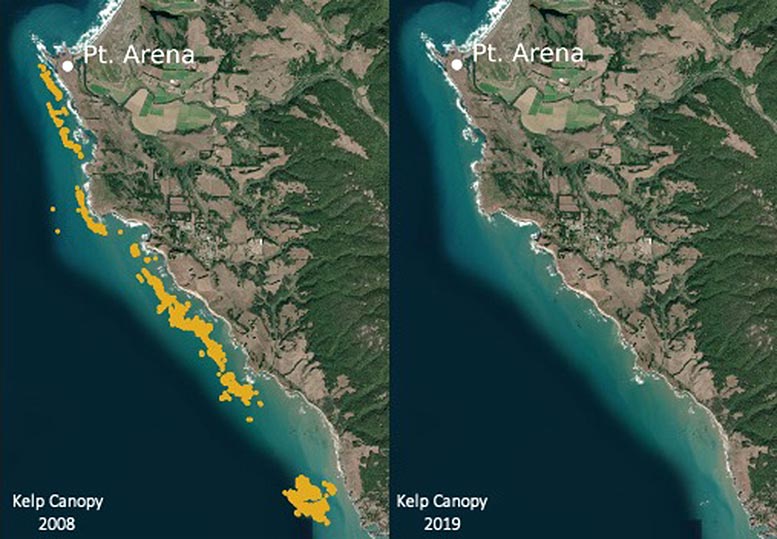
Satellite images show the dramatic reduction from 2008 to 2019 in the area covered by kelp forests (gold) off the coast of Mendocino and Sonoma Counties in Northern California. Credit: Meredith McPherson
Most of Northern California’s kelp forest ecosystem is gone, replaced by widespread ‘urchin barrens’ that may persist long into the future, according to a new study.
Satellite imagery shows that the area covered by kelp forests off the coast of Northern California has dropped by more than 95 percent, with just a few small, isolated patches of bull kelp remaining. Species-rich kelp forests have been replaced by “urchin barrens,” where purple sea urchins cover a seafloor devoid of kelp and other algae.
A new study led by researchers at UC Santa Cruz documents this dramatic shift in the coastal ecosystem and analyzes the events that caused it. This was not a gradual decline, but an abrupt collapse of the kelp forest ecosystem in the aftermath of unusual ocean warming along the West Coast starting in 2014, part of a series of events that combined to decimate the kelp forests.
Published today (March 5, 2021) in Communications Biology, the study shows that the kelp forests north of San Francisco were resilient to extreme warming events in the past, surviving other strong marine heatwaves and El Niño events. But the loss of a key urchin predator, the sunflower sea star, due to sea star wasting disease left the kelp forests of Northern California without any predators of sea urchins, which are voracious grazers of kelp.
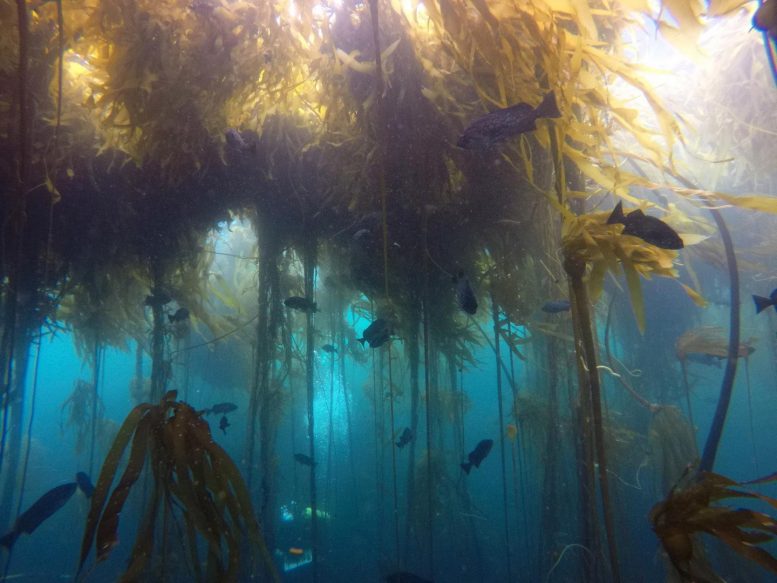
Bull kelp (seen here at Pescadero Point) is the dominant species of canopy-forming kelp in Northern California. Credit: Steve Lonhart/NOAA, MBNMS
“There were a lot of disruptions at one time that led to this collapse, and the system now persists in this altered state,” said first author Meredith McPherson, a graduate student in ocean science at UC Santa Cruz. “It’s a naturally dynamic system that has been really resilient to extreme events in the past, but the die-off of sunflower stars caused the resilience of the ecosystem to plummet. As a result, the kelp forests were not able to withstand the effects of the marine heatwave and El Niño event combined with an insurgence of sea urchins.”
The researchers used satellite imagery from the U.S. Geological Survey’s Landsat missions going back to 1985 to assess historical changes in kelp forest canopy cover.
Bull kelp is the dominant canopy-forming kelp species north of San Francisco Bay, while giant kelp is dominant to the south. Both species thrive when strong upwelling of cold, deep water brings nutrients to the surface along the coast. Marine heatwaves and El Niño events suppress coastal upwelling, resulting in warm water and low nutrient conditions in which kelp grows poorly.
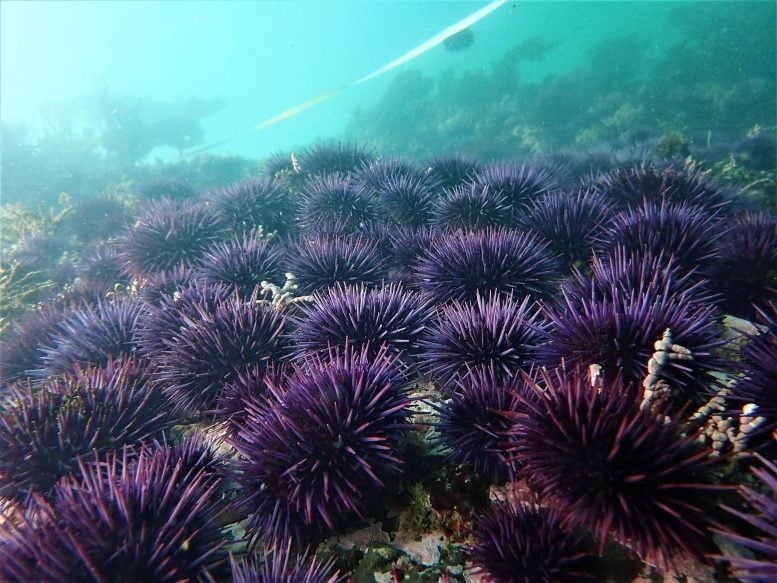
Most of the kelp forest ecosystem in Northern California has been replaced by urchin barrens like this one in a popular dive spot. Credit: Katie Sowul/CDFW
“There have been big changes before, when a strong El Niño has reduced the kelp canopy dramatically, but in the past it’s always come back,” said coauthor Raphael Kudela, professor and chair of ocean science at UC Santa Cruz. “The loss of resiliency is what made this time different–the combination of ocean warming and the loss of the sea stars allowed the urchins to take over.”
Sea star wasting disease first appeared in 2013, affecting all types of sea stars along the West Coast. The sunflower sea star was among the hardest hit species and was recently listed as critically endangered by the International Union for Conservation of Nature.
Late 2014 saw the advent of an unusual marine heatwave in the Northeast Pacific which became known as “the blob” as it spread down the West Coast in 2015. A strong El Niño event began to develop around the same time, bringing warm water up the coast from the south. The warm water coincided with an increase in sea urchin populations along the North Coast.
“The alignment of all of those events resulted in an incredibly dramatic loss of kelp,” Kudela said.
Kelp forests declined all along the California coast, but not to the same extent as in Northern California. Bull kelp is an annual species that regrows each year, which may make it more sensitive to these stressors than giant kelp. But another critical difference in Northern California is the absence of other urchin predators such as sea otters, which have enabled patches of healthy kelp forest to persist in Monterey Bay, for example.
“Sea otters haven’t been seen on the North Coast since the 1800s,” McPherson said. “From what we observed in the satellite data from the last 35 years, the kelp had been doing well without sea otters as long as we still had sunflower stars. Once they were gone, there were no urchin predators left in the system.”
What that means for the future, she said, is that the prospects for recovery of the Northern California kelp forests are poor unless sunflower sea stars or some other urchin predator returns to the system. Even if temperature and nutrient conditions are good for kelp growth, new kelp plants will have a hard time getting established in the midst of the urchin barrens.
There have been some efforts to have divers manually remove urchins from selected areas and see if that can help the kelp to recover, led by the Reef Check California Program (which contributed subtidal survey data for the study). An outbreak of sea urchin disease could also potentially lead to mass mortality of urchins and give the kelp a chance to recover. In the absence of some mechanism to reduce the urchin populations, however, it will be hard to restore and maintain the kelp forests, according to McPherson.
“There’s a lot of research and discussion now about the best management strategies for the future,” she said. “It’s important to understand and monitor the whole system. If we’re going to undertake restoration efforts, we need to make sure to do it when the temperature and nutrient conditions are right for the kelp.”
Kudela said ocean temperatures are beginning to cool down along the coast, after remaining above normal since 2014. “This year we are finally seeing ocean temperatures starting to cool off, so we’re hoping that it reverses naturally and the kelp is able to take off again,” he said. “There’s really not much we can do except to keep monitoring it. Of course, the long-term solution is to reduce our carbon emissions so we don’t have these extreme events.”
Reference: “Large-scale shift in the structure of a kelp forest ecosystem co-occurs with an epizootic and marine heatwave” by Meredith L. McPherson, Dennis J. I. Finger, Henry F. Houskeeper, Tom W. Bell, Mark H. Carr, Laura Rogers-Bennett and Raphael M. Kudela, 5 March 2021, Communications Biology.
DOI: 10.1038/s42003-021-01827-6
In addition to McPherson and Kudela, the coauthors of the paper include Mark Carr, professor and chair of ecology and evolutionary biology at UC Santa Cruz; Dennis Finger at UC Berkeley; Henry Houskeeper at UC Santa Cruz (now at UCLA); Tom Bell at UC Santa Barbara; and Laura Rogers-Bennett at UC Davis. This work was supported in part by the National Science Foundation.


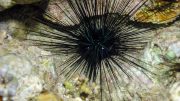




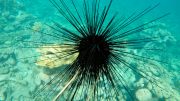

Wow, your articles seem to have a distinctly anti-carbon bias and I’m commenting here because this is one of the more egregious: despite clear causal attribution (reduction in kelp coverage due to increase in urchin population, and that due to decline in sea star population) and negative correlation with warming (local ocean waters have been cooler since 2014), the prescription for solving this condition is “to reduce our carbon emissions so we don’t have these extreme events.” Huh???—how could this cause-effect-solution possibly follow in an unbiased mind?
To the narrow point of the concern, perhaps researchers can consider moving some sea otter population into the fringe areas, which should supply some kelp cover and an incredible feeding ground to the otters while helping to control the sea urchin population naturally.
To the broader discussion regarding carbon, I think it would be helpful for researchers to open their minds to consider all of the factors that ‘got us here’ up to the past 40 years—those processes have not magically stopped, but seem to ignored by many…
Climate change proponents seem to disregard the fact that Earth was perfectly capable of creating and dissipating a monumental ice age—with ice sheets more than a mile thick over parts of the U.S.—over the time span of about 10,000 years without human intervention, starting a comparatively recent 20,000 years ago. Or that we have an increasing worldwide human population with most of us now capable of ‘net heating’ the environment year-round, particularly through winter heating and summer air conditioning—how could some net heating of the environment not occur through that process?
But perhaps there’s not enough grant money in researching those and other potential causation factors—best to jump on the anti-carbon bandwagon and chase the money!